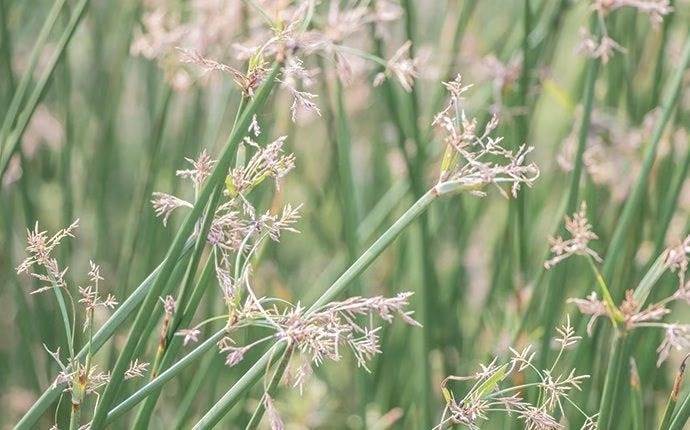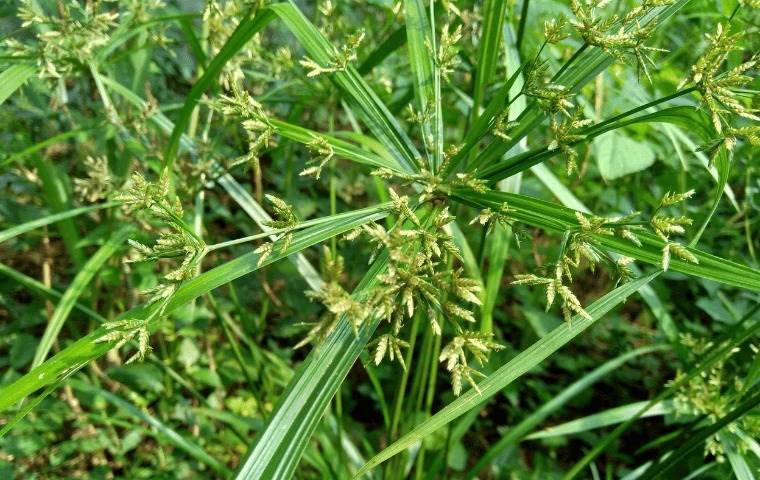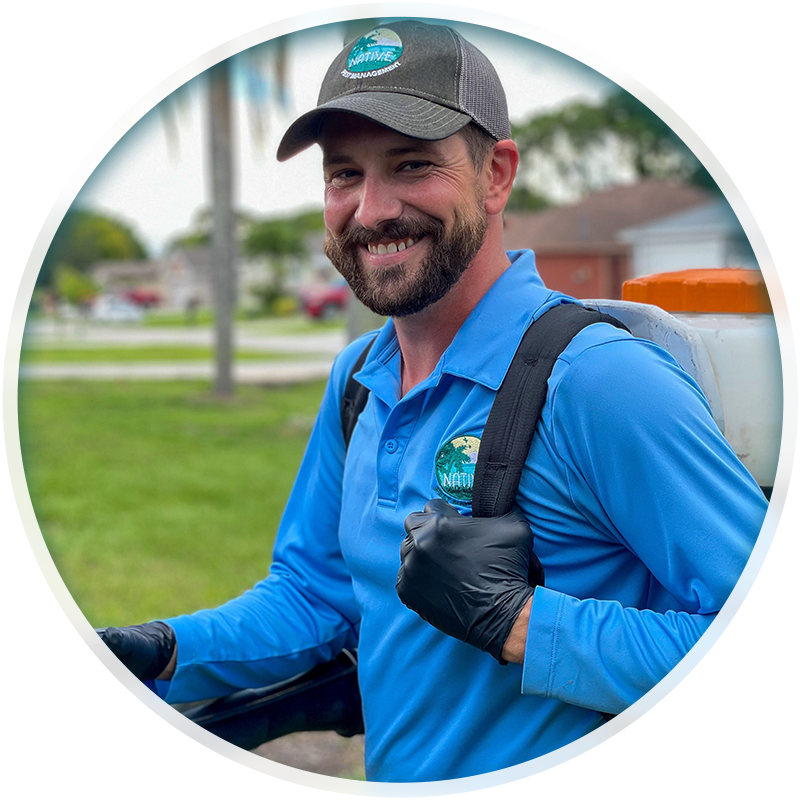
Sedge Weed Identification In South Florida
What Are Sedge Weeds?

Sedges are perennial plants that are found in shallow water or moist soil. Depending on the species these weeds can reach up to 4 feet in height. They are grass-like in appearance and often grow in thick clusters. Listed below are descriptions of some of the most common species of sedge found taking over South Florida lawns.
Nutsedge: Yellow and purple nutsedge has a triangular shape to its stem. Yellow nutsedge’s light green or yellow leaves are arranged in groups of three. Their leaves have tapered leaf tips and the leaves have a waxy appearance. As their name describes, yellow nutsedge produce yellow seed heads while purple nutsedge produces purple seed heads.
Globe sedge: Globe Sedge is a grassy weed with densely tufted stems. Its flat blades are very dense and bright green in color. After branching at the top of its stem it produces seeds in loose globe-like clusters.
Annual sedge: Annual sedge has a seed head that tends to be relatively large compared to other sedges. The seed head is flattened with a toothed outline. Annual sedge tends to grow together in clumps.
Are Sedge Weeds Invasive?
In South Florida, sedge weeds are a persistent problem and are difficult to control. They often form dense colonies, and can easily take over lawns and crops fields. In our landscape, they compete with our wanted grasses and plants, taking over the water, sun, and nutrients they need to grow. Like other species of weeds, sedge weeds are unwelcome and cause our lawns to become damaged and unhealthy.
Since sedge weeds grow faster than warm-season turfgrasses including St. Augustine grass, Zoysiagrass, and Bermuda grass, these weeds are very noticeable in well-manicured lawns. They quickly rise up higher than the desired grasses, and can easily be seen when they are present in your lawn.
-
Do mosquito control services work?
When you choose to have professional mosquito control performed on your property, you will see a dramatic reduction in the mosquito populations around your yard.
By maintaining monthly treatments, these results will continue. We are so confident in the effectiveness of our mosquito control programs that we guarantee them with free follow-up treatments if needed in-between regular services.
-
How do you control mosquitoes in the yard?
At Native Pest Management, our technicians start their mosquito control service by inspecting your landscape for standing water. We then treat the standing water we find every month with biological larvicides to prevent mosquitoes from breeding.
Then, we perform a pet safe mosquito misting of the landscape to eliminate adult mosquitoes and prevent mosquitoes from finding harborage in your landscape. This guaranteed service should last approximately 30 days.
-
Can pest control get rid of mosquitoes?
No pest control treatment will eliminate every mosquito on your property.
However, with our two-step mosquito control service, we have been told by product manufacturers to expect a 90% reduction in the mosquito population.
Since we believe in the effectiveness of our mosquito control programs, we guarantee them with free follow-up treatments if needed in-between regular services.
Why Do I Have A Sedge Weed Problem?
The biggest reason you have a problem with sedge weeds is that the warm, humid, wet climate in South Florida promotes their growth. Sedge weeds naturally want to establish themselves in marshy areas or water run-offs. Lawns with irrigation problems or that are over-watered are most at risk for experiencing problems with sedge weeds.

Where Will I Find Sedge Weeds?
Most species of sedge weeds are perennial, which means they return yearly for many years. Sedge weeds thrive in waterlogged soil or very moist. Though once established, they will thrive in a variety of soil types.
How Do I Get Rid Of Sedge Weeds?
At Native Pest Management, we understand that having a lawn full of weeds is not ideal. Controlling and managing sedge weeds is difficult, time-consuming, and frustrating. The best way to eliminate sedge weeds and control them long-term is to partner with a professional. To help you maintain your lawn and sanity, we offer monthly or bi-monthly lawn treatments that will eliminate sedge weeds and give you peace of mind knowing that your lawn will become and stay healthy throughout the year.
Native Pest Management can accurately identify the intruder and then provide the routine lawn care services needed to get rid of the weeds and stop them from returning. If sedge weeds have taken over your South Florida yard, contact Native Pest Management, we can help!
How Can I Prevent Sedge Weeds In The Future?
Preventing an invasion of sedge weeds can be difficult. The best solution to your sedge weed problem is to partner with the professionals at Native Pest Management. We know West Palm Beach lawns and how to keep them free of invasive weeds.
In addition to giving us a call, doing the following can help to deter sedge weeds.
- Fix low-lying areas in your lawn that allow water to collect and pool. Usually, sedge weeds are present in the swale along the street due to water accumulating in this area.
- Raise your mower height to at least 3.5 inches for St. Augustine grasses. Taller turf blades shade the soil, preventing sunlight from hitting the sedge weed seeds in the soil which prevents these weeds from germinating.
- Trim trees and other plants that are making your lawn shady during the day. For optimal health and to dry out enough, warm-season turfgrasses need at least eight hours of sunlight daily.
- Do not over-water your lawn. Deep, infrequent watering is the goal. We recommended watering your lawn a maximum of three days a week. If your lawn continues to appear dry, increase the minutes to run each irrigation zone. If your lawn is still dry at this point, there is likely a coverage problem where the water isn't hitting all areas of your lawn when the sprinklers turn on. At this point, you should get a "wet check" performed by a licensed irrigation company.
- Make sure your irrigation only runs during early morning hours. If your sprinklers turn on in the afternoon or evening hours, water will likely sit on the grass overnight, increasing the likelihood of sedge weeds spreading.
- Ensure that irrigation systems are not distributing too much water. Over time, there can be pressure imbalances that may need to be fixed by a licensed irrigation company.
- Make sure to aerate your soil so that it doesn’t become too compacted. Compacted soil prevents water from draining through the soil. Good soil aeration should remove plugs of soil at least 1 inch deep.
- Keep your lawn well-fertilized. A thick turf canopy will help prevent sunlight from hitting areas of exposed soil in your lawn, which would give sedge weed seeds an opportunity to germinate and spread.
If you are experiencing problems with sedge weeds, contact Native Pest Management. We would be happy to help you rid your lawns of sedge weeds. Call today to learn more about our effective lawn care services!

Why Choose Native Pest Management?
We Exceed Customer Expectations
-
Pet Friendly & Environmentally ConsciousNative Pest Management applies our pest control products with the safety of your family and pets in mind! We also offer eco-friendly pest control to protect your family and the planet.
-
Local Service ProfessionalsSince 2015, we have served communities in West Palm Beach and all throughout South Florida. Our team is fully licensed, insured, and vetted.
-
On TimeOur team will not only arrive on time, but they’ll also go above and beyond when providing service. It’s what makes us one of the top rated pest control companies in Florida! We strive for complete customer satisfaction every time.
-
Get a 100% Free Estimate
Whether you currently have pests in your home or simply want to start professional pest prevention, take the first step to a pest-free life, and contact us today for your free pet-friendly pest control quote.
-
“Warren took his time with the servicing and was very knowledgeable! Exceptional customer service. I will be requesting him each time.”- Montiea Singletary
-
“Excellent service by Chino from Native Pest Management. Chino went above and beyond to make sure we understood everything about the service and kept us very informed during the process.”- Brand Gonzalez
-
“Truly professionals at what they do. very respectful very knowledgeable and great attitude.”- Jorge Acosta
-
“I called and spoke to the manager, who was polite and courteous, and even though it cost them money to come back out and spray, they did not charge me again, and I was very thankful.”- S. Williams
-
“Dale is the absolute best in the business of pests! My sister and I personally ask for him every single time because he always goes above and beyond.”- Zariah Graham
-
“The technician was very professional. He explained things thoroughly and put me at ease with what was about to happen in my home.”- Anthony Diaz
-
“Native pest management always exceeds my expectations! The people who answer the phone are so nice and accommodating and make scheduling a breeze! The techs are always so nice and do a great job.”- Michelle Cato
-
“Extremely impressed with the technicians I met today. Tony and Jamie. Very thorough and customer oriented. I am expecting great things for my trees and plants.”- Curt Kredo

Native Pest Management's Blog
Want all the latest news or updates? Browse through our blog to read our most recent posts and featured articles.







